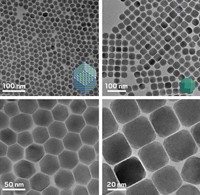Advertisement
Grab your lab coat. Let's get started
Welcome!
Welcome!
Create an account below to get 6 C&EN articles per month, receive newsletters and more - all free.
It seems this is your first time logging in online. Please enter the following information to continue.
As an ACS member you automatically get access to this site. All we need is few more details to create your reading experience.
Not you? Sign in with a different account.
Not you? Sign in with a different account.
ERROR 1
ERROR 1
ERROR 2
ERROR 2
ERROR 2
ERROR 2
ERROR 2
Password and Confirm password must match.
If you have an ACS member number, please enter it here so we can link this account to your membership. (optional)
ERROR 2
ACS values your privacy. By submitting your information, you are gaining access to C&EN and subscribing to our weekly newsletter. We use the information you provide to make your reading experience better, and we will never sell your data to third party members.
Synthesis
Quantum dots offer a brighter future for photocatalysis
Nanosized semiconducting particles work as well or better than ruthenium and iridium catalysts in C–C bond-forming reactions
by Stephen K. Ritter
April 3, 2017
| A version of this story appeared in
Volume 95, Issue 14

Photocatalysis has added a new dimension to organic synthesis in recent years, enabling chemists to develop more-efficient routes to complex molecules. Looking to take that success to another level, a research team at the University of Rochester has used small amounts of inexpensive quantum dots to seamlessly replace organic dyes and ruthenium and iridium complexes traditionally used as photocatalysts in C–C bond-forming reactions (J. Am. Chem. Soc. 2017, DOI: 10.1021/jacs.6b13379). Quantum dots are up-and-coming nanosized semiconducting materials best known for applications in biomedical imaging and color displays, but they have also been used to harvest light for metal catalysts in hydrogen production. Taking the catalysis application a step further, Rochester’s Jill A. Caputo, Todd D. Krauss, Daniel J. Weix, and coworkers found that 3-nm CdSe quantum dots with surface-capping carboxylate and phosphine ligands—they could be called “photodots”—can replace various types of photoredox catalysts in a set of standard reactions, including β-alkylation (shown), β-aminoalkylation, and reductive dehalogenation. The researchers note that quantum dots are inherently more light-stable, absorb more photons, have longer-lived excited states, and have broader absorption spectra than the other photocatalysts. The CdSe quantum dots aren’t a panacea for photocatalysis, Weix notes, as they aren’t effective for all the reaction types tested, but other sizes or types of quantum dots might prove even more useful.



Join the conversation
Contact the reporter
Submit a Letter to the Editor for publication
Engage with us on Twitter